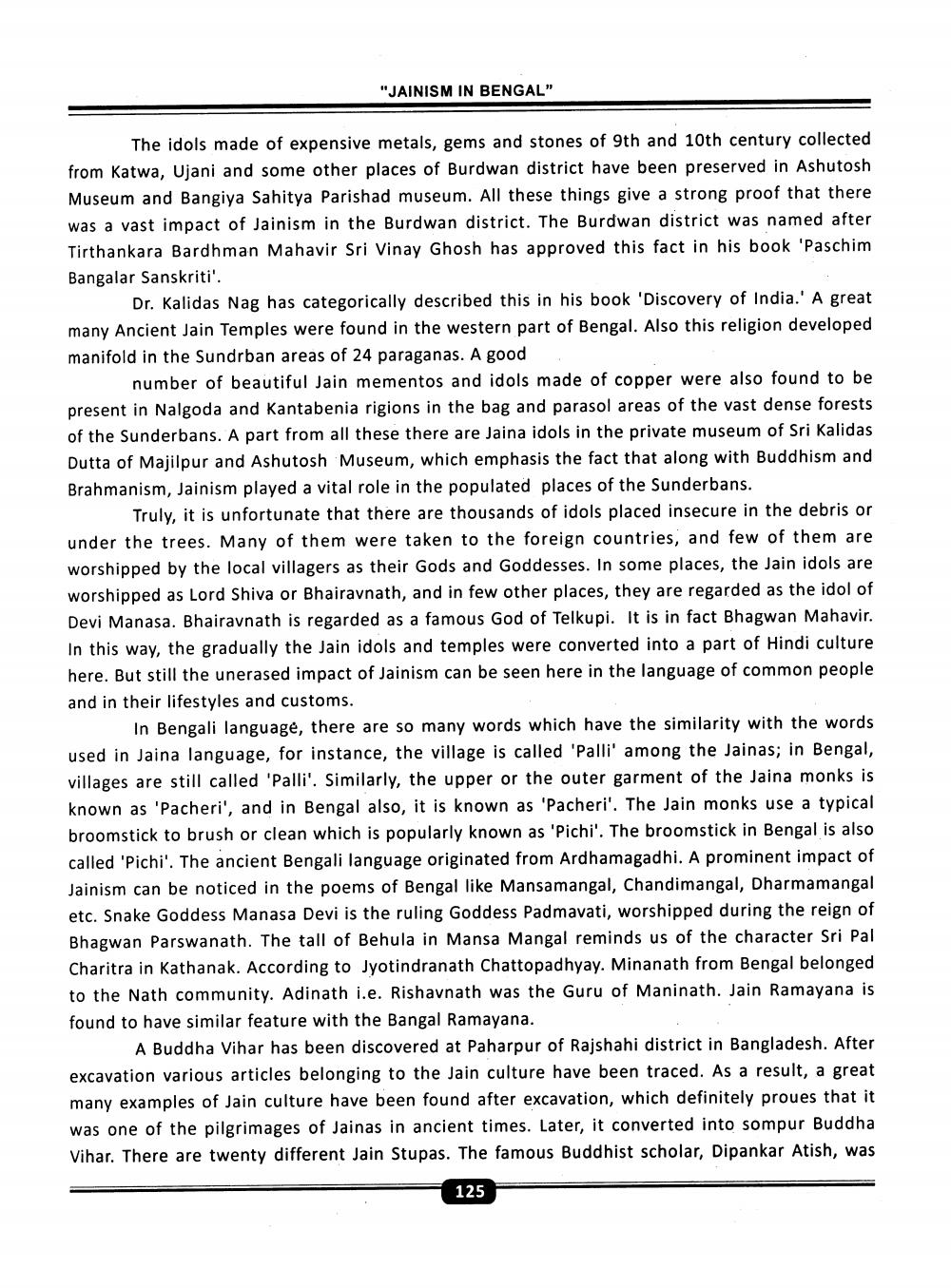________________
"JAINISM IN BENGAL"
The idols made of expensive metals, gems and stones of 9th and 10th century collected from Katwa, Ujani and some other places of Burdwan district have been preserved in Ashutosh Museum and Bangiya Sahitya Parishad museum. All these things give a strong proof that there was a vast impact of Jainism in the Burdwan district. The Burdwan district was named after Tirthankara Bardhman Mahavir Sri Vinay Ghosh has approved this fact in his book 'Paschim Bangalar Sanskriti'.
Dr. Kalidas Nag has categorically described this in his book 'Discovery of India.' A great many Ancient Jain Temples were found in the western part of Bengal. Also this religion developed manifold in the Sundrban areas of 24 paraganas. A good
number of beautiful Jain mementos and idols made of copper were also found to be present in Nalgoda and Kantabenia rigions in the bag and parasol areas of the vast dense forests of the Sunderbans. A part from all these there are Jaina idols in the private museum of Sri Kalidas Dutta of Majilpur and Ashutosh Museum, which emphasis the fact that along with Buddhism and Brahmanism, Jainism played a vital role in the populated places of the Sunderbans.
Truly, it is unfortunate that there are thousands of idols placed insecure in the debris or under the trees. Many of them were taken to the foreign countries, and few of them are worshipped by the local villagers as their Gods and Goddesses. In some places, the Jain idols are worshipped as Lord Shiva or Bhairavnath, and in few other places, they are regarded as the idol of Devi Manasa. Bhairavnath is regarded as a famous God of Telkupi. It is in fact Bhagwan Mahavir. In this way, the gradually the Jain idols and temples were converted into a part of Hindi culture here. But still the unerased impact of Jainism can be seen here in the language of common people and in their lifestyles and customs.
In Bengali language, there are so many words which have the similarity with the words used in Jaina language, for instance, the village is called 'Palli' among the Jainas; in Bengal, villages are still called 'Palli'. Similarly, the upper or the outer garment of the Jaina monks is known as 'Pacheri', and in Bengal also, it is known as 'Pacheri'. The Jain monks use a typical broomstick to brush or clean which is popularly known as 'Pichi'. The broomstick in Bengal is also called 'Pichi'. The ancient Bengali language originated from Ardhamagadhi. A prominent impact of Jainism can be noticed in the poems of Bengal like Mansamangal, Chandimangal, Dharmamangal etc. Snake Goddess Manasa Devi is the ruling Goddess Padmavati, worshipped during the reign of Bhagwan Parswanath. The tall of Behula in Mansa Mangal reminds us of the character Sri Pal Charitra in Kathanak. According to Jyotindranath Chattopadhyay. Minanath from Bengal belonged to the Nath community. Adinath i.e. Rishavnath was the Guru of Maninath. Jain Ramayana is found to have similar feature with the Bangal Ramayana.
A Buddha Vihar has been discovered at Paharpur of Rajshahi district in Bangladesh. After excavation various articles belonging to the Jain culture have been traced. As a result, a great many examples of Jain culture have been found after excavation, which definitely proues that it was one of the pilgrimages of Jainas in ancient times. Later, it converted into sompur Buddha Vihar. There are twenty different Jain Stupas. The famous Buddhist scholar, Dipankar Atish, was
125




